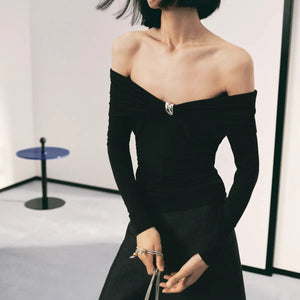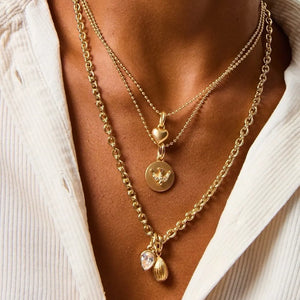
A photo from Zara's "The Whispers of the Wild" campaign, photographed by Steven Meisel. From zara.com
Here's the uncomfortable truth we all carry around: we want to be conventionally beautiful. We know what the algorithm likes, what gets the likes, what makes people do a double-take for all the "right" reasons. But the faces that actually stop us mid-scroll? The ones we're still thinking about three days later? They're never quite right. There's always something that doesn't fit—some feature that breaks the rules.
I saw this Zara campaign recently (Steven Meisel shot it, Karl Templer on styling) and I keep pulling it back up on my phone. They used several models, all completely different, but two of them have lodged themselves in my brain. Leo and Emile. These aren't your standard-issue pretty boys. These are faces. Can't just shake them.
When a Portrait Becomes a Poem

One more picture of Emile and Leo. Steven Meisel, zara.com
Look at these images—really look at them. If you stumbled across these portraits in a dusty literature anthology, you'd immediately think: poets. And you'd probably have a pretty good sense of what kind, too. There's this artistic, rebellious quality to them. Something soulful. It's not accidental—that's what happens when striking features meet exceptional styling and photography.
Let's dissect why these faces work so powerfully.
Emile: The Intensity of a Hawk

For me, it all began with this portrait. Steven Meisel, zara.com
Okay, Emile's face (a person on the right, with a scarf). So his eyes are deep-set, but they're also close-set—which, you'd think those two things together would be weird? But instead it creates this gaze that feels like a bird of prey studying its next move. Maybe a hawk zeroing in. Everything else about his face stays calm, his mouth is relaxed, nearly serene even, but then you get to those eyes and it's a completely different story. There's this focus there, this tension. It makes you feel like you're being studied, which is a little unsettling if I'm being honest. He's looking at you, but also through you somehow. And that's what close-set, deep-set eyes do—they create this piercing thing. Like the person is actually listening, seeing past whatever you're saying to what you mean. It gets under your skin, but—I don't know how else to put this—in a good way? You just can't look away.
And those lashes? The almond shape? Half the women I know would trade a kidney for eye shape like Emile's. The irony is delicious—he possesses traits considered the height of feminine beauty standards, yet channels them into something entirely his own.
Leo: The Sanpaku Mystery

A close-up of Leo's face, cropped from a group photo. Steven Meisel, zara.com
Leo's working with something totally different. Rounder eyes, fuller lips—features that typically read as feminine. But the masculine energy coming off him? It's intense. Which seems contradictory until you really look at what's happening with his eyes.
He's got this pronounced lower eyelid exposure thing going on, as well as what is called scleral show—you can see the white of his eye on both sides of the iris, plus there's extra space showing below. In Japan they even have a specific word for it: sanpaku eyes. "Three whites." Think Sylvester Stallone. Not exactly a feature people are usually requesting, you know? It can make you look tired, startled, a little sad sometimes.
Here's the thing, though—we never actually see faces as individual features lined up in a row. That's not how your brain processes a face. You take in everything at once, the whole package.
Everything else about Leo is screaming vitality: that incredible hair, those medium-thick brows, skin that looks genuinely healthy. So the scleral show doesn't make him less attractive—it just makes him more complicated. It adds this vulnerability to all that masculine energy. Your brain has to pause and figure him out. Like, was he born for war or for love? You can't really pin it down. And that's what makes him magnetic—the fact that you can't neatly categorize him. The inability to do that makes someone impossible to forget.
The Mathematics of Visual Weight

I've found three photos of these models together, and the synergy is unreal. Steven Meisel, zara.com
When you place a person with high visual weight—striking, unusual features that command attention—in front of a camera, people's gazes naturally linger. The face holds their attention.
But when you put two people with high visual weight together, and those features are completely different? You multiply that effect exponentially. The portrait becomes a dialogue. Your eye keeps moving between them, comparing, trying to figure out what makes each one work. It's why these images hold your attention longer than most things you scroll past. They need more processing time.
So if you've been hard on yourself about your eyes—you know, the spacing, the shape, the sanpaku thing, whatever doesn't fit what Instagram is telling you looks good this week—maybe stop doing that. The thing you've decided is a flaw? That might be exactly what people remember about you. They might find it mesmerizing. Not despite it being "wrong." Because of it.
Quick Styling Observation (And a Trick You Can Use)

Campaign group image (with a few models missing). Check the necklines: every outfit has something interesting going on. Steven Meisel, zara.com
Before you close this tab, let me share one of the smartest styling choices in this campaign. Notice how Templer and his team framed those faces: scarves, interesting necklines, contrast lapels, necklaces, and an abundance of texture concentrated right in the portrait area. They also created dimension through strategic hair styling.
This works for everyone, by the way. And I mean everyone. Want to draw more attention to your face? Frame it. It's like framing a diamond. You wouldn't just set it in nothing, right? You'd give it a setting that makes people look twice. Same concept here—earrings, hair accessories, interesting collars, any kind of detail or visual interest close to your face.
Your face is the artwork. The styling creates the frame. The frame doesn't compete with the art; it makes you look at the art harder.
Lastly
Conventional beauty is easy. It's comfortable. It photographs well in harsh algorithmic lighting. But interesting? Interesting requires something else. Something "wrong." Something that makes people pause, squint, lean in closer.
The next time you're tempted to surgically correct or filter away your distinctive features, remember Emile's predator-sharp gaze and Leo's sanpaku vulnerability. Remember that the faces we can't forget are never the perfect ones.
They're the ones that make us wonder.




